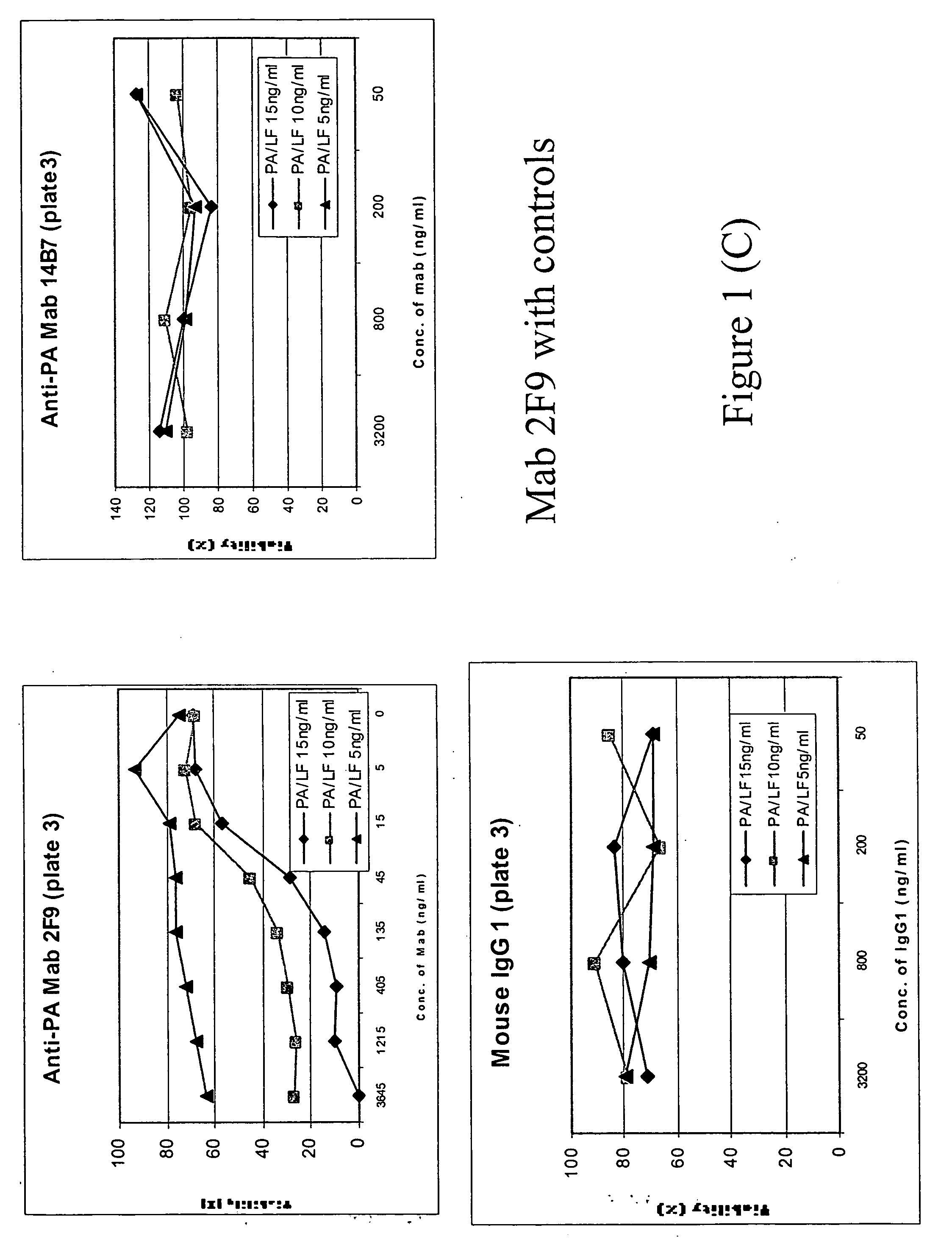Methods and compositions for conversion of antibody activity
a technology of antibody activity and composition, applied in the direction of antibacterial agents, drug compositions, antibody medical ingredients, etc., can solve the problems of incomplete protection, impure and chemically complex, ineffective removal of immune complexes, etc., to prevent or and reduce the symptoms of exposure to anthrax spores
- Summary
- Abstract
- Description
- Claims
- Application Information
AI Technical Summary
Benefits of technology
Problems solved by technology
Method used
Image
Examples
example 1
Identifying Non-Neutralizing Anti-PA Antibodies
Macrophage viability assay was used to determine whether an anti-PA antibody is non-neutralizing.
Material and Reagents:
The assay used microtiter well plates with MTT as detection agent. Cells were suspended in DMEM at 106 / ml. Macrophage: J774 A1 cells at 6# passage, viability was 93%, passed to 3 plates. Calibration: cell # (×103): 100, 80, 75, 60, 45, 30, 15, 0. Rest of the wells: 105 cells / well.
Procedure:
1. diluted PA / LF and anti-PA MAbs in a dilution plate;
2. incubated at 37° C. in a CO2 incubator;
3. transferred 50 μl / well of mix into 100 μl / well macrophage cells;
4. continued incubation at 37° C. CO2 incubator for 4 hours;
5. added 25 μl / well MTT solution, incubated for 1 hour; and
6. added 100 μl / well lysing / solubilization solution, incubated at 37° C. overnight.
Result:
The percentage of survived macrophage cells was plotted against the concentration of the antibodies, and the results are shown in FIG. 1.
Concl...
example 2
Comparison of the Performance of Non-Neutralizing Monoclonal Antibody 3F3 and a Bispecific Molecule Comprising 3F3 / 19E9 in J774 Macrophage
Materials and Reagents:
Monkey Erythrocytes: baboon blood from Lampine Bio Labs, Cat # B1-180N-10, Lot # 102938800 (#4). Macrophage cells: J774A1, passage #3, viability was 94.8%, passed at 2×106 cells / ml. rPA (2.2 mg / ml), Lot # 102-72 (aliquoted by CF) NB199-20, diluted 1:100 (2 μl aliquot+198 μl DMEM). Lethal factor (LF) (1.45 mg / ml), Lot # 199-38. It was diluted 1:100 (2 μl aliquot+198 μl DMEM). Shaking speed was 2.1. HP sample: H4-19E9×3F3 MAb (PEG), Lot # 175-91A, concentration was 309.4 μg / ml. The bispecific molecule was produce by cross-linking a deimmunized anti-CR1 MAb, 19E9, and a non-neutralizing anti-PA antibody, 3F3, using N-succinimidyl S-acetyl thioacetate (SATA) and NHS-poly (ethylene glycol)-maleimide (PEG-MAL) as the cross-linking agents.
Procedure:
1. Diluted HP as below (based on molar ratio of PA): add 50 μl to set with e...
example 3
Macrophage Viability Assay with Soluble CR1
PUM
| Property | Measurement | Unit |
|---|---|---|
| Therapeutic | aaaaa | aaaaa |
| Immunogenicity | aaaaa | aaaaa |
Abstract
Description
Claims
Application Information
 Login to View More
Login to View More - R&D
- Intellectual Property
- Life Sciences
- Materials
- Tech Scout
- Unparalleled Data Quality
- Higher Quality Content
- 60% Fewer Hallucinations
Browse by: Latest US Patents, China's latest patents, Technical Efficacy Thesaurus, Application Domain, Technology Topic, Popular Technical Reports.
© 2025 PatSnap. All rights reserved.Legal|Privacy policy|Modern Slavery Act Transparency Statement|Sitemap|About US| Contact US: help@patsnap.com



